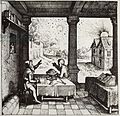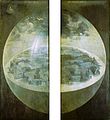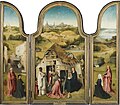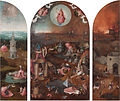User:Rhododendrites/images
Appearance
Miscellaneous collections of stuff from the Commons (not my own work).
Technology, media, computers, robots, automata
[edit]Automata
[edit]-
Vaucanson duck automaton, destroyed on 1879
-
Mechanical Duck, built by Jaques de Vaucanson (1738, France)
The Turk
[edit]-
copper engraving depicting The Turk chess "computer" (1783)
-
Wolfgang von Kempelen's fraudulent Chess automaton, later exhibited by Johann Nepomuk Maelzel (1789)
-
From book that tried to explain the illusions behind the Kempelen chess playing automaton (known as The Turk) after making reconstructions of the device
Historical computers
[edit]-
Wilhelm Shickard's calculating machine, 1623
-
a 'Pascaline', the mechanical calculator invented and manufactured by French scientist Blaise Pascal around 1642
-
another Pascaline
-
Calculating device invented by Samuel Morland (1625-1695). "Machina Nova Cyclogica pro Multiplicatione. Or, A new Multiplying Instrument." Illustration in: "The description and use of two arithmetick instruments", London : Printed by M. Pitt, 1673
-
Leibniz's Stepped Reckoner, invented ~1672 (the first calculating machine to be able to do all four arithmetic operations)
-
another Stepped Reckoner
-
Difference Engine of George B. Grant at the US Centennial Exhibition, Phillagelphia (1876)
-
A 1991 construction of Charles Babbage's Difference Engine by The London Science Museum
-
close-up of Difference Engine replica
-
Replica of Babbage's Analytic Engine
Machines
[edit]-
Book-sewing machine with two attendants. from the 1911 Britannica
Old media
[edit]-
Phenakistoscope animation
-
Zoopraxography at Hong Kong Science Museum
Humans <3 technology
[edit]Pre-1800
[edit]-
Nicolas IV de Larmessin (1684–1753) - Habit de Marêchal
-
a woodcut showing full and cutaway views of an artificial leg with joints at the knee and ankle (1575)
Pre-1950
[edit]-
Glass eyes made by Ludwig Müller-Uri (19th century)
-
Old Advert from a Hungarian newspaper, 1918. "Are You amputed? Looking for a fine prosthesis?..."
-
"We'll All Be Happy Then". Cartoon depicting technological luxuries of the future, by Harry Grant Dart, 1911
-
The brain of Charles Babbage in a museum next to his machines
-
Utopian flying machines of the previous century (French trading card from the turn of the 20th century)
1950-present
[edit]-
Scratch input using a stick, with computer-vision by wearable camera system, 2006
-
An electrically powered exoskeleton suit currently in development by Tsukuba University of Japan
-
the evolution of wearable computers
Magic, mysticism, occult
[edit]-
Albertus Magnus - De secretis mulierum
-
Quatrain illustration by Edmund J. Sullivan to the Rubaiyat of Omar Khayyam
-
Fasciculus chemicus frontispiece
-
from Michael Maier's Atalanta fugiens, emblema XXI, 1618
-
Alexander von Suchten, 1680
-
Sahl ibn Bišr al-Isra'ili - Verzeichnis und Ausslegungen Zebelis (1669)
-
D. Stolcius von Stolcenbeerg: Viridarium chymicum, 1624. (Trismegistos.jpg)
-
Hermes Trismegistus (unknown artist)
-
Diagram of the names of God in Oedipus Aegyptiacus - Athanasius Kircher
-
Heinrich Khunrath - Amhitheatrum sapientae aeternae (1606)
-
Macrocosm and microcosm - engraving attached to Basilica Philosophica, third volume of Johann Daniel Mylius’ Opus Medico-Chymicum, Frankfurt - 1618
-
Alchemy by James Gillray
-
Pieter Brueghel the Elder - The Alchemist (1558, Ink on paper) Engraved by Philipp Galle
-
“The alchemical sisters,” from Johann Daniel Mylius, Philosophia reformata (1622)
-
Emblem numbered 16 and captioned 'Multiplicatio' from J.D. Mylius - Philosophia Reformata. Engraved by Balthazar Schwan (1622)
-
Mutus Liber title page, La Rochelle 1677 edition - Isaac Baulot
-
Hauptbild der Bad Teinacher kabbalistischen Lehrtafel (~1660)
-
J. Ch. Schellenberg - Der Stein der Weisen
-
Cornelis Pietersz Bega - De Alchemist (1663)
-
Sir William Fettes Douglas - The Alchemist (1853)
-
Carl Spiztweg - Der Alchimist (~1860)
-
Devil in the Codex Gigas
Books/collections
[edit]Amphitheater of Eternal Wisdom by Heinrich Khunrath (1595)
[edit]Zoroaster Clavis Artis (1738)
[edit]Organizations
[edit]Rosicrucianism
[edit]-
The grave of Christian Rosenkreuz, depicted as the Philosophers' Mountain. The date 1604 signifies the event, not the original date of publication. (Geheime Symbole, 1785)
-
The Rosicrucian Invisible College
People
[edit]Aleister Crowley
[edit]-
Aleister Crowley Abode of Chaos
Robert Fludd (1574-1637)
[edit]-
Utriusque cosmi maioris scilicet et minoris […] historia, tomus II (1619), tractatus I, sectio I, liber X, De triplici animae in corpore visione
-
Robert Fludd's Tractatus
-
Robert Fludd's Tractatus
-
Temple of Music?
-
Temple of Music?
-
Vitruvian man
-
An Astrologer Casting a Horoscope (from Utriusque Cosmi Historia, Oppenheim, 1617)
-
Robert Fludd: Der Mensch als Mikrokosmos
Maps, celestial representations, astrology
[edit]-
Southern hemisphere constellations scenographically over the terrestial globe. Plate from Andreas Cellarius Harmonia Macrocosmica of 1661. Since the celstial sphere is seen from "outside", the sides are reversed wrt. to the view for a terrestrial observer
-
The Astrologer who Fell into a Well. Fable by Jean de La Fontaine. Illustration 18th century
-
Woodcut by Erhard Schoen (1491-1542), image illustrates a natal horoscope for Leonhard Reymann, 1515
-
"Cometa, qui anno Christi 1742 apparuit, ex observationibus, a die 13 Marty usque ad 15 Aprilis," chart to the comets by the German engraver and map publisher Matthäus Seutter. Circa 1742
-
Andreas Cellarius - Southern hemisphere constellations scenographically over the terrestial globe (1661)
-
Ortelius World Map "Typvs Orbis Terrarvm" (1570)
Philosophy, knowledge
[edit]Age of Reason, Enlightenment
[edit]-
"The Age of Reason or the World turned Topsyturvy exemplified in Tom Paine's works!!" (1819)
-
Trippy Denis Diderot
Places, environments
[edit]-
Kimberley diamond mine (1874). from the 1911 Britannica
-
San Francisco fire after the earthquake of 1906, seen from Sacramento Street
Buildings, architecture
[edit]-
Amiens Cathedral. from the 1911 Britannica
Cities
[edit]-
people tube
-
Shibuya, Tokyo, Japan 2008/05/14
Ruins, decay
[edit]-
"Abandoned structure"
-
Piscina Mirabilis at Baiae. from the 1911 Britannica
Science, nature
[edit]-
Pilea involucrata
Creatures [real]
[edit]-
cat with an ocular prosthetic
-
Male and Female Superb Fairy-Wren.Taken in Ensay, Victoria
-
Pomeranian. from the 1911 Britannica
Creatures [drawings in scientific atlases, bestiaries, encyclopedias, etc.]
[edit]-
The Opossum, Didelphimorphia, from Albertus Seba's Thesaurus
-
from Albertus Seba's Thesaurus
-
from Albertus Seba's Thesaurus
Creatures [other]
[edit]-
Mock taxidermy of a rhinograde (Rhinogradentia) at the Musée zoologique de la ville de Strasbourg. (fictitious animal devised by a fictitious naturalist, Harald Stümpke)
Medicine
[edit]-
According to tradition, the man portrayed is the Hungarian nobleman Gregor Baci, who was healed after having a lance pierce his right eye during a tournament (early 17th century)
-
Trapanation illustration (19th century?)
Physiology
[edit]Eadweard Muybridge Animations
[edit]Most of these from Descriptive Zoopraxography, or the Science of Animal Locomotion made Popular by Eadweard Muybridge (1893)
-
Athletes Running. Animated by rotating in steps of 1⁄12 rotation (to neutralise the overall forward motion of the nearer, slower, runner) at a frame rate of 10/sec (1893)
-
Athlete, Standing Long Jump. Animated by rotating in steps of 1⁄13 rotation (according to Muybridge's instructions) at a frame rate of 10/sec (1893)
-
Village Blacksmiths. Animated by rotating in steps of 1⁄13 rotation (according to Muybridge's instructions) at a frame rate of 10/sec.
-
The Gallop of the Dog
-
Reduced tracing of some phases from Plate 758 of "Animal Locomotion"
-
Athlete, Running High Jump
-
Egyptian Camel Racking. Animated by rotating in steps of 1⁄12 rotation (to neutralise the overall forward motion) at a frame rate of 10/sec
-
Monkeys Climbing a Cocoa Palm. Animated by rotating in steps of 1⁄13 rotation (according to Muybridge's instructions) at a frame rate of 10/sec.
-
Monkeys Climbing a Cocoa Palm.
-
Lion Walking.
-
Pigeons Flying. Animated by rotating in steps of 1⁄12 rotation (to neutralise the overall forward motion) at a frame rate of 10/sec.
Psych
[edit]Phrenology
[edit]-
Phrenology Journal
-
Friedrich Eduard Bilz (1842–1922): Das neue Naturheilverfahren
-
19th century Phrenology chart, from Fowlers&Wells
Sky and space
[edit]-
photo at ESO’s Paranal Observatory, Chile. A group of astronomers were observing the centre of the Milky Way using the laser guide star facility at Yepun
-
Polar aurora. from Meyers Konversationslexikon (1885-90)
Science fiction
[edit]-
Alien tripod illustration by Alvim Corréa, from the 1906 French edition of H.G. Wells' "War of the Worlds"
Art [that doesn't fit in other categories]
[edit]-
18th century French lace from the 1911 Britannica
Artist-specific
[edit]Hieronymous Bosch (1450-1516)
[edit]-
Cutting the Stone by Hieronymous Bosch (late 15th/early 16th century) (removing the stone of madness)
-
painting after Hieronymous Bosch's Cutting the Stone (removing the stone of madness)
-
The Garden of Earthly Delights by Hieronymous Bosch (late 15th century). Also see annotated/detailed version
-
The Garden of Earthly Delights closed
-
The Hermit Saints Triptych
-
The Haywain Triptych (also see annotated/detailed version)
-
Death and the Usurer (Death and the Miser)
-
The Conjurer
-
Triptych of the Adoration of the Magi
-
The Last Judgment
-
The Pedlar
-
Saint John the Evangelist on Patmos
-
Saint John the Baptist in the Desert
-
The Seven Deadly Sins
-
The Temptation of Saint Anthony
-
Visions of the Hereafter
Engravings
[edit]-
Humani Victus Instrumenta: Ars Coquinaria, 1569
-
Frontispiece to Hobbes's Leviathan
-
Frontispiece from Thomas Hobbes' De Cive
-
Battle of Slankamen 1691 (1702)
-
Garden of mayor Johannes Schwindt, Frankfurt am Main. Engraving by Matthäus Merian, 1641
-
Frankfurt - Matthaus Merian (~1612)
-
Frontispiece to Albert Seba's Thesaurus
-
from Ephraim Chambers's Cyclopaedia, Volume 1
-
Manufacturing plant of dragée. from Dictionnaire encyclopédique de l'épicerie et des industries annexes
-
Frontispiece to the Encyclopedie (1802)
Paintings
[edit]-
Heinrich Hoerle's Denkmal der unbekannten Prothesen (1930)
-
Giulio Romano (1499–1546) - Allegoria dell'immortalità
-
"The Broad and the Narrow Way", English version of the German pietist image "Der schmale und der breite Weg", as spread by Gavin Kirkham



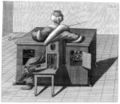






















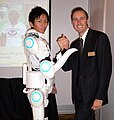














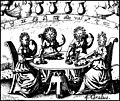




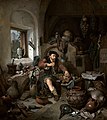




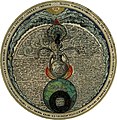

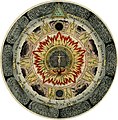







![Utriusque cosmi maioris scilicet et minoris […] historia, tomus II (1619), tractatus I, sectio I, liber X, De triplici animae in corpore visione](http://upload.wikimedia.org/wikipedia/commons/thumb/0/0c/RobertFuddBewusstsein17Jh.png/82px-RobertFuddBewusstsein17Jh.png)






